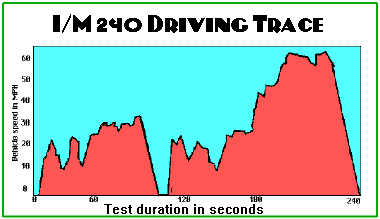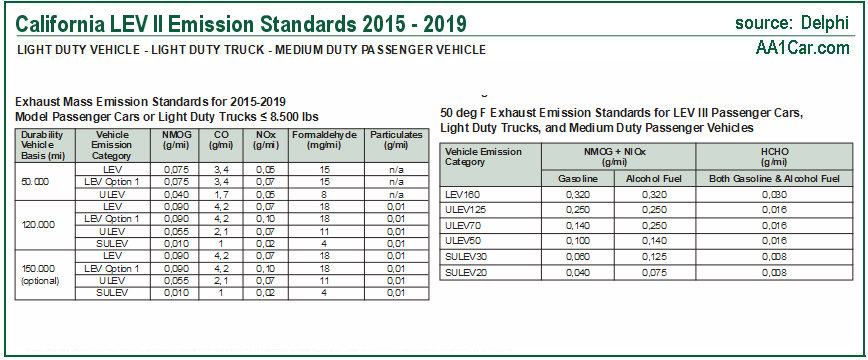
Auto Repair Library, Auto Parts, Accessories, Tools, Manuals & Books, Car BLOG, Links, Index



I/M 240 is an "enhanced" inspection/maintenance vehicle emissions testing program for improving air quality in areas that fail to meet the federal government's ambient air quality standards. The test is similar to the Federal Test Procedure (FTP) that auto makers use to certify new vehicle emissions.
A key feature of the I/M 240 test procedure is the use of a special inertia dynamometer to simulate vehicle loads at various speeds during a 240-second drive cycle that includes acceleration, deceleration and cruise modes. The test can catch emission problems that often escape notice during a simple idle emissions test, but it requires a trained operator to "drive" the vehicle while it is on the dyno, and the special dyno that is required is very expensive. A single I/M 240 test lane can cost upwards of $150,000 or more!
The I/M 240 test also measures oxides of nitrogen (NOx) in the exhaust, and uses a special continuous gas collection system rather than a partial gas sampling system to analyze the exhaust. The equipment monitors vehicle emissions for the duration of the test, then calculates the average emissions and displays the results in grams per mile for NOx, CO and HC (rather than the more familiar parts per million or percent of concentration).

The I/M 240 test also requires an "evaporative purge flow test" while the engine is running to measure the flow rate of the charcoal canister purge valve, and an engine off pressure test of the evaporative emission control system to check for fuel vapor leaks.
Other elements of the program include centralized vehicle testing by a single contractor, required training and certification for technicians who do emission repairs, and higher repair waivers (up to $450) for vehicles that fail to pass the test.
In areas that do not meet federal air quality standards, the U.S Environmental Protection Agency (EPA) has dictated that these areas must use some type of enhanced emissions testing such as I/M 240 or a similar loaded mode test method, or use an OBD II plug-in test (for 1996 and newer vehicles). Areas that do not comply suffer the consequences (withholding of federal highway funds, withholding environmental building permits, invoking various injunctions, fines, etc.).
Those who opposed I/M 240 (and there are many!) said:
The EPA, by comparison, claims I/M 240 can potentially reduce HC and CO emissions by 5 to 30%, and NOx emissions up to 10%
In 2000, the EPA recognized the objections to I/M 240 and decided to allow a more flexible approach to enhanced emissions testing. The EPA decided it would allow states to choose whatever enhanced test procedure works best for their situation be it I/M 240, ASM testing on a constant speed dyno or some other loaded test procedure that also includes NOx and evaporative emissions.
The latest twist in the evolution of I/M 240 emissions testing is the OBD II plug-in test for 1996 and newer vehicles. The OBD II test uses the vehicle's own computer to monitor emissions compliance. There is no actual measurement of tailpipe emissions, nor is the vehicle placed on a dyno. Instead, a computer is plugged into the vehicle's diagnostic connector to see (1) if the OBD II sysem is functioning properly, (2) that there are no stored fault codes and (3) that the Malfunction Indicator Lamp (MIL) is not on. If the OBD II system has run all its self-checks and the vehicle is in emissions compliance, it passes the plug-in test. But if the MIL lamp is on, the vehicle fails the test and may be subjected to a repeat plug-in test or some type of loaded mode emissions test on a dyno.
As I/M 240 and the whole issue of emissions testing continues to evolve, it is possible that advances in onboard diagnostics may make the need for periodic emissions testing unnecessary, at least for newer vehicles.
Maine was the first state to make the I/M 240 plunge back in 1995. The state and repair industry were both ill-prepared to handle the rigors of I/M 240 testing, and the public backlash that followed forced the governor to cancel the program.
Colorado was the next to adopt a modified I/M 240 program, also in 1995. Other states with I/M 240 programs include Arizona, Wisconsin, Ohio, Indiana and Maryland. I/M 240 programs are also coming in Washington D.C. (January 1999), Illinois (January 1999) and Missouri.
ASM enhanced test programs are used in California, Delaware, Georgia, New Jersey, Virginia and Connecticut. Pennsylvania has used ASM testing in the Philadelphia area, and other areas.
New York, Massachusetts and Rhode Island use a NYTEST239 test procedure, which is a sort of hybrid version of ASM and I/M 240 testing that includes transient mode testing on a dyno but uses a less costly exhaust sampling system.
Though some states still use a simple idle test to check emissions, the ones that do not meet air quality standards mostly use some type of enhanced loaded mode dyno emissions testing or the new OBD II plug-in test.
One trend that is helping to minimize the inconvenience of having to take an emissions test is extending the time period between tests for newer, low mileage vehicles. In some states, testing is only required every other year and may not be required at all until a vehicle is four years old.
Changes in California's Smog Check II program are a good indication of the direction that other states forced to adopt enhanced emissions testing may follow. When the federal Clean Air Act was amended in 1990, the U.S. Environmental Protection Agency initially mandated a centralized, state-run enhanced vehicle emissions testing program (I/M240) that would have eliminated privately-owned Smog Check stations (a $480 million per year industry in California). California negotiated an alternative plan with the EPA that would achieve the same reductions in vehicle emissions without such draconian measures.
The new emissions testing program enhancements were enacted into law in 1994 and approved by the EPA on September 26, 1996. Subsequent legislation has further refined the Smog Check II program to include the following elements:
Enhanced areas include all of Orange County, southern Ventura County, western San Diego County, most of Los Angeles county, parts of Riverside and San Bernardino counties, and the urbanized areas of Sacramento, Fresno, Stockton, Modesto, Bakersfield, Davis, Vacaville, Palm Springs, and Hemet-San Jacinto.
In less smoggy "basic areas" enhanced emissions testing is not required and the existing biennial two-speed idle test at licensed test-and-repair stations remains the same as before. Basic emissions testing is required for vehicles that are being sold or are being registered in California for the first time.
The dyno is used primarily for checking NOx emissions. To get accurate NOx readings, the engine must be under load to produce the high combustion temperatures that form NOx.
The only problem with using a dyno is that some all-wheel drive and four-wheel drive vehicles cannot be driven on a two-wheel dyno, nor can some vehicles with traction control systems. These vehicles will be exempt from the enhanced emissions test but must still pass a two-speed idle test.
Test results are transmitted electronically to the California Department of Motor Vehicles. Eliminating paper Smog Check certificates should reduce the potential for fraud.
Test-Only Stations are privately-owned Smog Check stations licensed by the Department of Consumer Affairs/Bureau of Automotive Repair (DCA/BAR) to inspect and certify vehicles (including gross polluters), but they do not fix emission problems. Repairs can be performed at "Gold Shield Guaranteed Repair" stations which are licensed Smog Check facilities that meet high performance standards and guarantee the repairs they make on gross polluters.
Remote Sensing Devices (road side sniffers) may also be used to catch gross polluters. Such devices use an infrared beam to identify gross polluters and a camera snaps a picture of the vehicle's license plate.
There is also an "economic hardship extension" for qualified low-income motorists. Like the Repair Cost Waiver, the extension is valid for two years and may be obtained only once during a motorist's ownership of a vehicle. However, to obtain an extension, motorists must spend $250 on emissions-related repairs at a licensed Smog Check station, or have an estimate from a licensed Smog Check station showing that a single repair would cost more than $250. Motorists must also verify their household income, which must be at or below 175% of the federal poverty level (about $29,000 a year for a family of four).
Neither the repair cost waiver nor the economic hardship extension can be obtained if the vehicle has a tampered emissions system, is being registered for the first time in California, is being sold, or was issued a waiver or extension in the previous Smog Check inspection.
California also offers "low income repair assistance" to help low-income motorists pay for emissions-related repairs. The program will help pay for vehicle repairs that are cost-effective and maximize clean air benefits. The motorist must make a $250 co-payment, with the state contributing an additional amount not to exceed $450. Repairs must be performed at a Gold Shield station.
Enhanced emissions testing with a vehicle under load on a dyno (either steady speed or transient) continued for older vehicles (pre-1996) in some states, as will NOx testing and evaporative emission checks on some vehicles (such as diesel-powerd light trucks). Most states, however, have switched to the easier and faster (and cheaper) OBD II plug-in emissions test.
The question is will all of this make a significant difference in improving overall air quality? When much of the Third World thumbs its nose at even the most rudimentary efforts to reduce pollution, and rain forests are being burned at an alarming rate, one cannot help but question the cost effectiveness of emissions testing in the overall scheme of things. Certainly, doing something is better than doing nothing.
As we move forward, the amount of pollutants allowed in the exhaust continues to be reduced. That includes carbon monoxide (CO), unburned hydrocarbons (HC), formaldehyde (HCHO), non-methane organic gases (NMOG), oxides of nitrogen (NOx) and particulate matter (PM). Here are some current federal and California emission standards:



 More Emissions Articles:
More Emissions Articles:  Click Here to See More Carley Automotive Technical Articles
Click Here to See More Carley Automotive Technical Articles Be sure to visit our other websites:
Be sure to visit our other websites: